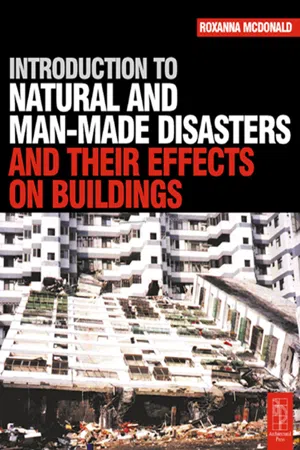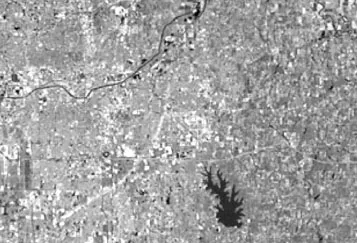![]()
1 Introduction
Definition
The Oxford Dictionary defines disaster as a: Sudden or great misfortune, calamity, great failure, ill starred event – (DIS+GK ASTRON star), which gives an indication of how we perceive disaster: unpredictable, outside our control, and overpowering; an event, controlled by the stars and gods!
From antiquity to modern times, human existence has been marked by the dramatic effects of nature's hazardous power. Despite catastrophic events, man did not give up, he tried to fight it, tried to coexist with it, and tried to control it.
Most disaster sites have remained populated; sometimes through faith in tradition and continuity, more often due to increased poverty and inability to travel to a better place. Archaeological excavations have revealed that at the time the city of Pompeii was destroyed by the eruption of Mount Vesuvius, many buildings had just been repaired following damage from an earthquake. All the same, the village of Pompeii and surrounding settlements continue to be populated to this day. The wine from the vines planted on the warm mountain slopes is just as sought after now as it was in Roman times, and tourists watch happily the guides frying eggs on the hot bare ground near the volcano's crater.
In building terms, man's best efforts, like the seven wonders of the ancient world, were time and time again defeated by nature. The Colossus of Rhodes was destroyed by an earthquake in 224 BC, as was the Mausoleum of Halicarnasus in 1402. The Alexandria Lighthouse survived a first earthquake in 500, as well as deliberate Arab attempts to demolish it in the ninth century. Having escaped further earthquakes in 1182 and 1303, it was finally destroyed, in 1375, by yet another earthquake.
With the advance of science and technology, man has significantly improved his ability to cope with nature's might, but at the same time, he has also brought onto himself a new set of problems: global warming, ecological disasters, mutating life forms.
When talking of disasters, most people tend to think of natural hazard events, but this is no longer the case. There are natural disasters: such as earthquakes, floods, tornadoes, hurricanes, droughts, volcanic eruptions etc. man-made disasters such as war, terrorism, or industrial accidents, and also disasters such as wild fires, which can be both, or man-made disasters that can trigger natural ones and vice versa.
Whether we regard nature as a mysterious force to be feared and placated with offerings or as a generous ‘Mother Earth’ in need of our protection, Nature cannot be ignored and man is constantly learning how to coexist with its unpredictable behaviour.
But when do Nature's actions change from spectacular displays into disasters? When does man's scientific and social progress become calamity?
From the safety of home, remoteness of satellites or TV we are amazed to see that extreme weather such as hurricanes and tornadoes can be so powerful as to leave a trail visible from space (see Fig. 1.1). We are mesmerized by the flowing lava of an active volcano and astonished at the effect an earthquake can have on the landscape. We feel inspired and scientists use these phenomenon to advance man's ability to survive adversity.
The same phenomena cease to be fascinating and are no longer just scientific data when they happen in densely populated areas causing major loss of human lives and livelihoods, as well as the destruction of economic and social infrastructures, or environmental damage. They become disasters.
During the past four decades, natural hazards such as earthquakes, droughts, floods, storms and tropical cyclones, wild land fires, and volcanic eruptions have caused substantial devastation. Economic losses have increased almost 10 times during this period.
Fig. 1.1
Satellite view of tornado path over Oklahoma. © USDA United States Department of Agriculture.
Although recent natural disasters have not been the century's worst, their cost in human lives, homelessness, and economic disruption has escalated. The reasons for this are being put down to:
•An increase in frequency of natural phenomena. The explanations for this vary and have been subject to considerable ongoing debate: global warming, climate change, the destruction of the ecological balance through unscrupulous depletion of natural resources by man, deforestation, planetary evolution influencing the Earth's structure and behaviour.
•An increase in world's population moving into areas vulnerable to earthquakes, landslides, flooding, and other natural hazards. Poverty and population increase mean that a growing number of people have no other choice but to move to vulnerable or unsafe areas where housing is cheaper or easily available whilst the better off are able to move to safer buildings and locations.
•Economic conditions in the developing world. Poverty and social economic pressure often make people more vulnerable as they often have to move to unsafe land because there are no alternative at reasonable cost close to employment opportunities. Also, economic factors create an increasing infrastructure vulnerability either through lack of understanding by decision makers or by tendency by some builders to use the cheapest design and materials for increased short-term returns on their investments.
A United Nations evaluation assesses that in addition to the projected estimation of 100000 lives lost each year due to natural hazards alone, the anticipated global cost of natural disasters will top US$ 300 billion annually by the year 2050. (Source: United Nations background Paper No. 5 for WSSD – World Summit on Sustainable Development.)
The compounded effects of natural and man-made catastrophes pose escalating threats to humankind on a multitude of inter-related levels. Governments, multilateral agencies, and non-governmental organizations (NGOs) facing the urgent need to find solutions, are uniting their efforts to find an international strategy for disaster reduction and risk management, but despite general good intentions it is proving a difficult task, as economic and political priorities have continued to prevent conclusive action.
At the 1992 Earth Summit in Rio, 172 governments took part at the conference, which examined the link between sustainable development and the environment. The subsequent climate conference, leading to the Kyoto agreement, created the framework to reduce global warming through reducing carbon dioxide emissions, but the withdrawal of the United States has been a serious setback.
In September 2002, at the Johannesburg Summit, participants discussed ways of creating a solid basis for implementing sustainable development but progress on firm commitment has been disappointing. In the context of a number of United Nations actions, a concerted effort is evolving towards developing policies and measures to enable societies to: (a) be more resilient to hazards; (b) undertake developments that do not increase vulnerability to hazards.
While no country in the world is entirely safe, developing countries are most exposed due to their inability to limit the impact of hazards. An estimated 97% of natural disaster related deaths each year occur in developing countries and the percentage of economic loss in relation to the gross national product (GNP) far exceeds the one in developed countries. (Source: UN International Strategy for Disaster Reduction – background document to WSSD.)
The need to reverse trends in vulnerability is also highlighted by the fact that the emphasis on disaster response and humanitarian assistance has absorbed significant resources which would have been directed in development and risk reduction.
The subject of natural and man-made disasters is vast and the world is becoming more and more concerned with analysing, reviewing, and finding solutions.
The purpose of this book is to make a small step towards providing a general understanding of the principal types of disaster and, in particular, of the way in which they can affect buildings. By understanding how these natural and man-made events take place, how they evolve, and how they affect us, we stand a better chance to build and live safely in stronger communities resilient to disaster.
Disasters and buildings
In coping with disaster, man-made structures often cons...

